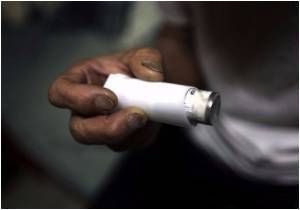
While he estimates it will be five years until such a product is on the market, Patwari says a network of wireless transceivers around a bed can measure breathing rates and alert someone if breathing stops without any tubes or wires connected to the patient.
"We can use this to increase the safety of people who are under sedation after surgery by knowing if they stop breathing," he says. "We also envision a product that parents put around their baby's crib to alert them if the baby stops breathing. It might be useful for babies at risk of SIDS."
The American Academy of Pediatrics says there is "no evidence that home monitors are effective" for preventing SIDS. Since 2005, the group has opposed the use of breathing monitors to prevent SIDS, but has said they "may be useful in some infants who have had an apparent life-threatening event," including some combination of apnea [abnormal interruptions in breathing], color change, limpness and choking or gagging.
"The AAP recognizes that monitors may be helpful to allow rapid recognition of apnea, airway obstruction, respiratory failure, interruption of supplemental oxygen supply, or failure of mechanical respiratory support," the group states.
In addition to other possible uses, Patwari wants to conduct research with doctors to test his method as an infant-breathing monitor, and, if it proves useful, develop it as a medical device that would need federal approval. He also says it may be useful for adults with sleep apnea, which causes daytime fatigue and impairs a person's performance.
Advertisement
Patwari says that with the new method, "the patient or the baby doesn't have to be connected to tubes or wired to other sensors, so they can be more comfortable while sleeping. If you're wired up, you're going to have more trouble sleeping, which is going to make your recovery in the hospital worse."
Advertisement
Yet many parents want monitors too. The AAP acknowledges "distribution of home monitors continues to be a substantial industry in the United States."
New Uses for Wireless Technology
Wireless technology has become pervasive, from wireless phones to wireless networks linking home computers. In 2009, Patwari and then-graduate student Joey Wilson showed how a couple dozen wireless transceivers – devices that transmit and receive radio signals – could be used to literally see through walls to detect the location of a burglar, people trapped by a fire or hostages held captive inside a building.
They formed a University of Utah spinoff company, Xandem Technology LLC, which is commercializing the wireless networks for use as motion detectors for burglar alarm systems, to help police locate hostages and even to alert out-of-town, vacationing parents if a crowd of teenagers is partying at their home during their absence.
Patwari's new study points out pros and cons of adding wireless detection of breathing to the motion-detecting capability.
"A search and rescue team may arrive at a collapsed building and throw transceivers into the rubble, hoping to detect the breathing of anyone still alive inside," Patwari and colleagues write. "Police or SWAT teams may deploy a network around a building to determine if people are inside."
"On the other hand, the ability to measure breathing from a wireless network has privacy implications," they add. "We have shown previously that a network deployed around external walls of a building can detect and track a person who is moving or changing position. If this system can also detect and monitor a sleeping person's breathing, it would have additional utility for eavesdroppers or thieves."
The Study: Using Wireless Transceivers to Detect Breathing
Source-Eurekalert









